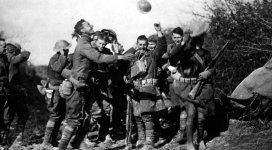teamzr1
Supporting vendor
1918
1919
November 11: President Wilson proclaims the first Armistice Day with the following words: "To us in America, the reflections of Armistice Day will be filled with solemn pride in the heroism of those who died in the country's service and with gratitude for the victory, both because of the thing from which it has freed us and because of the opportunity it has given America to show her sympathy with peace and justice in the councils of the nations." The original concept for the celebration was for the suspension of business for a two-minute period beginning at 11 A.M., with the day also marked by parades and public mettings1920
On the second anniversary of the armistice, France and the United Kingdom hold ceremonies honoring their unknown dead from the war. In America, at the suggestion of church groups, President Wilson names the Sunday nearest Armistice Day Sunday, on which should be held services in the interest of international peace.
1921
Congress passes legislation approving the establishment of a Tomb of the Unknown Soldier in Arlington National Cemetery. November 11 is chosen for the date of the ceremony. According to October 20, Congress declares November 11, 1921, a legal Federal holiday to honor all those who participated in the war.The ceremony was conducted with great success.
1926
Congress adopts a resolution directing the President to issue an annual proclamation calling on the observance of Armistice Day. Throughout the 1920s and 1930s, most states establish November 11 as a legal holiday and at the Federal level, an annual proclamation is issued by the President
1938
Congress passes legislation on May 13 making November 11 a legal Federal holiday, Armistice Day.
The United States has no 'actual' national holidays because the states retain the right to designate their own holidays. The Federal government can in fact only designate holidays for Federal employees and for the District of Columbia. But in practice, the states almost always follow the Federal lead in designation of holidays.
1941- 1945
1950- 1953
1950- 1953
World War II and the Korean War create millions of additional war veterans, in addition to those of the First World War already honored by Armistice Day.
1954
On June 1, President Eisenhower signs legislation changing the name of the legal holiday from Armistice Day to Veterans Day.
1968
Congress passes the Monday Holiday Law, which established the fourth Monday in October as the new date for the observance of Veteran's Day. The law is to take effect in 1971.
1971-1975
The Federal observance of Veterans Day is held on the fourth Monday of October. Initially all states follow suit except Mississippi and South Dakota. Other states changed their observances back to November 11 as follows: 1972- Louisiana and Wisconsin; 1974- Kentucky, Arkansas, Connecticut, Georgia, Maine, South Carolina, West Virginia; 1975- California, Florida, Idaho, Illinois, Iowa, Kansas, Missouri, Montana, Nebraska, New Hampshire, Oklahoma, Oregon, South Carolina, Utah, West Virginia, Wyoming
1975
Legislation passed to return the Federal observance of Veteran's Day to November 11, based on popular support throughout the nation. Since the change to the fourth Monday in October, 46 states had either continued to commemorate November 11 or had reverted back to the original date based on popular sentiment. The law was to take effect in 1978.
1978
Veteran's Day observance reverts to November 11.
Last edited:
